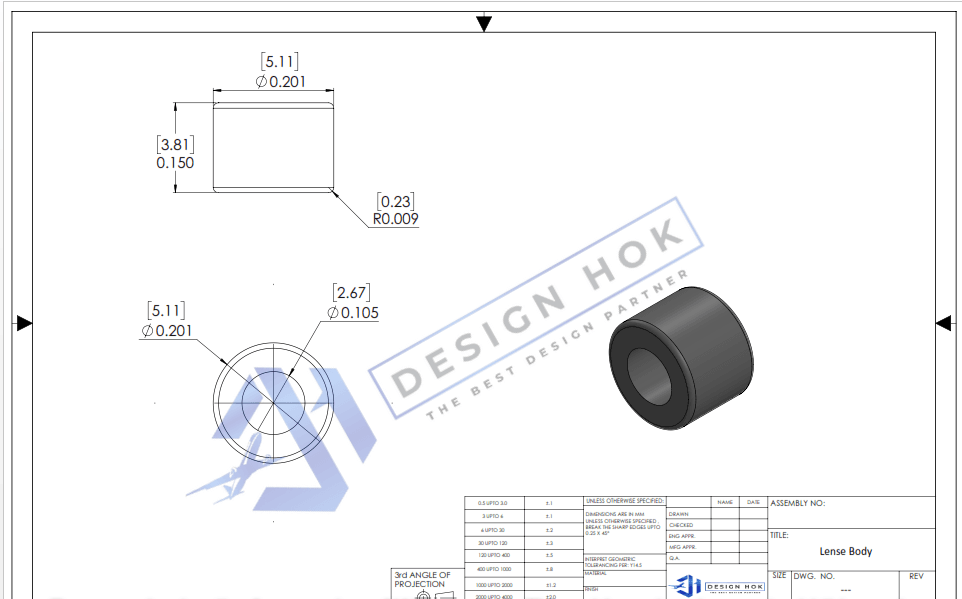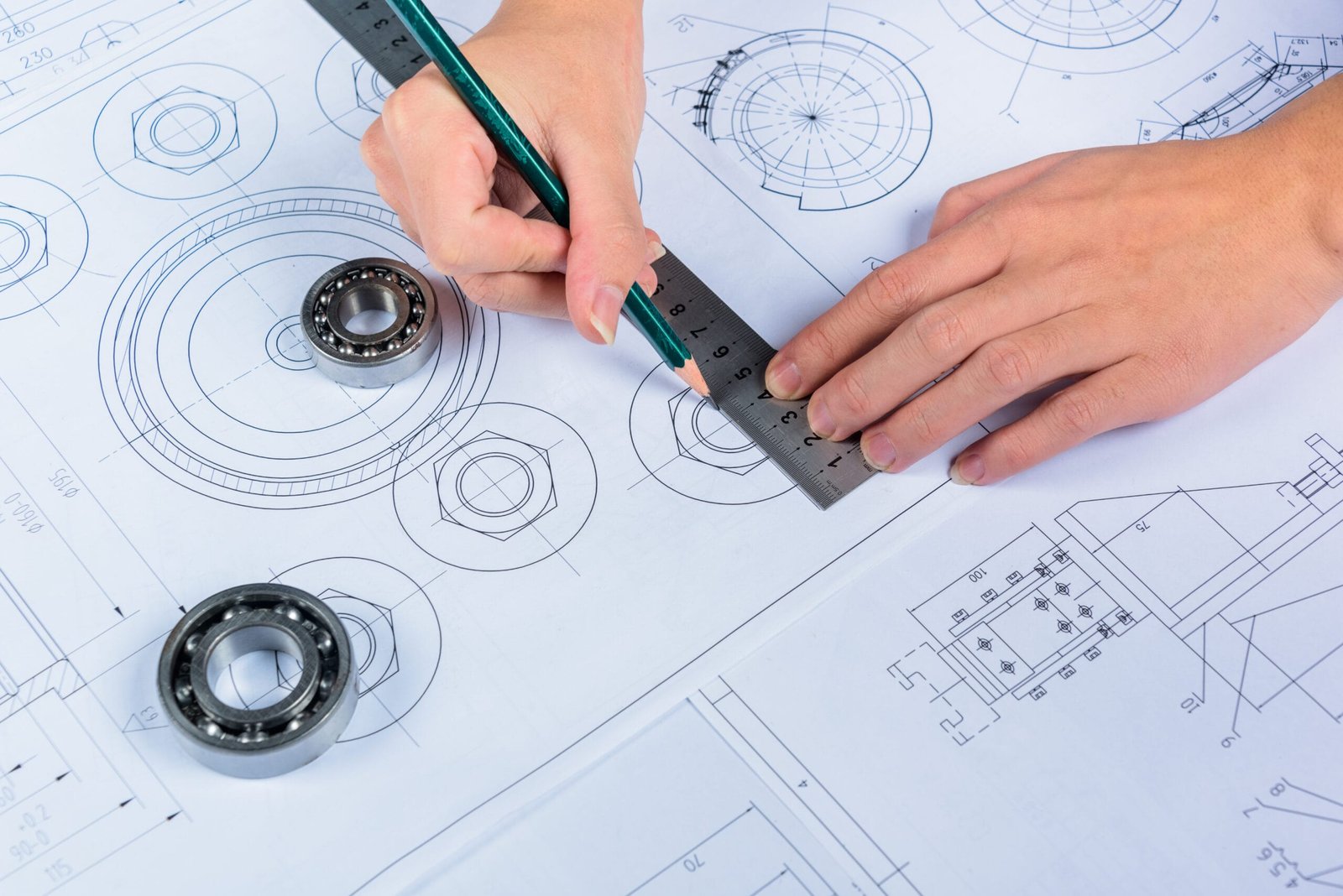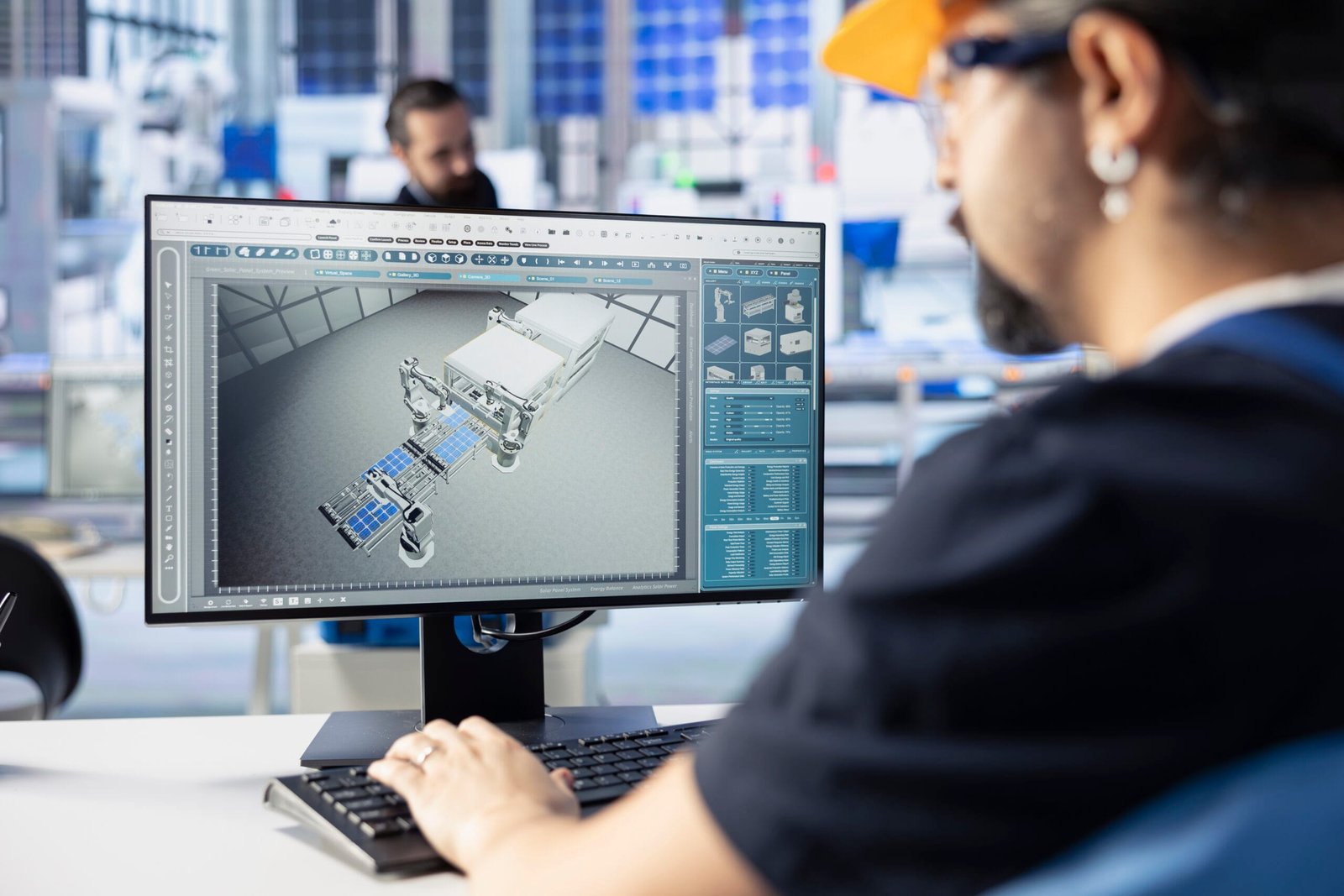Introduction
In manufacturing, accuracy is everything. If a part is even slightly off in size, shape, or surface finish, it could lead to machinery failure or safety issues. That’s why Mechanical Parts Inspection Tools are essential in every engineering workshop or production facility. These tools help ensure that every mechanical component meets quality standards before it reaches the customer.
In this guide, we’ll cover:
- What mechanical parts inspection tools are
- Why they matter
- The different types of tools
- How they’re used
- Tips for choosing the right one
- And answers to common questions (FAQ)
Let’s dive in.
What Are Mechanical Parts Inspection Tools?
Mechanical Parts Inspection Tools are instruments used to measure, check, and verify the physical properties of parts like gears, bolts, shafts, or casings. These tools help engineers and inspectors confirm if a part’s dimensions, angles, and surface features match the technical drawings or CAD designs.
These tools are used in:
- Manufacturing
- Automotive
- Aerospace
- Defense
- Oil & Gas
- Medical device industries
Why Are Mechanical Parts Inspection Tools Important?
✅ 1. Ensures Product Accuracy
Inspection tools help make sure every part is produced within acceptable tolerances.
✅ 2. Maintains Safety Standards
Poorly measured parts can cause system failures. Inspection prevents those risks.
✅ 3. Reduces Manufacturing Waste
By catching mistakes early, you avoid large batches of faulty products.
✅ 4. Builds Customer Trust
Clients know they can depend on your quality if parts are consistently inspected.
Categories of Mechanical Parts Inspection Tools
There are many tools used in mechanical inspection. Let’s explore them in simple words:
1. Linear Measurement Tools
These Mechanical Parts Inspection Tools are used to measure lengths, widths, and heights.
🔹 Vernier Caliper
Measures inside, outside, and depth dimensions up to 0.02 mm precision.
🔹 Micrometer
More precise than a caliper; used to measure tiny thicknesses (like wires or small rods).
🔹 Steel Ruler
Basic tool for rough measurements. Not very accurate but still useful for quick checks.
2. Angle and Shape Measuring Tools
Used to check angles and geometric shapes.
🔹 Protractor
A tool for measuring and drawing angles, typically in degrees.
🔹 Bevel Protractor
More advanced than a regular protractor, used to measure small and precise angles.
🔹 Angle Gauge Blocks
Used in precise angle measurement in inspection labs.
3. Surface Inspection Tools
These Mechanical Parts Inspection Tools check how smooth or rough a surface is.
🔹 Surface Roughness Tester
Gives a reading (Ra value) that tells how rough or smooth a surface is.
🔹 Surface Plate
A flat granite or metal surface used as a base to compare other parts’ flatness.
4. Dimensional & Geometric Tolerance Tools
These tools check features like roundness, parallelism, and squareness.
🔹 Dial Indicator
Detects small movements or irregularities on a surface.
🔹 Height Gauge
Measures vertical dimensions with high precision on a surface plate.
🔹 Coordinate Measuring Machine (CMM)
A computer-controlled device that checks complex dimensions and shapes with 3D accuracy.
5. Thread & Gear Inspection Tools
Special Mechanical Parts Inspection Tools for parts with threads or gears.
🔹 Thread Gauge
Checks the size and pitch of threads on bolts, screws, or nuts.
🔹 Gear Tooth Vernier
Used to measure gear tooth thickness and spacing.
6. Non-Contact Optical Tools
These tools don’t touch the part but still give accurate measurements.
🔹 Optical Comparator
Projects a part’s image on a screen to compare it with design outlines.
🔹 Laser Scanner
Creates a 3D scan of the object for comparison with the CAD model.
7. Hardness Testing Tools
Used to test how hard or soft a material is.
🔹 Rockwell Hardness Tester
Pushes a small ball into the material to see how deep it goes.
🔹 Brinell Tester
Used for softer metals and gives average hardness.
8. Portable Hand Tools
These are easy-to-carry tools often used on the production floor.
🔹 Feeler Gauges
Thin metal strips to check gaps or spacing.
🔹 Go/No-Go Gauges
Tells whether a part falls within the acceptable size limit.
9. Digital Inspection Tools
Modern tools that connect to software for real-time analysis.
🔹 Digital Calipers & Micrometers
Give accurate readings and can save measurements in a database.
🔹 3D Scanners
Used for reverse engineering and highly accurate inspections.
How Are These Tools Used in Real Life?
Let’s say you’re making a metal shaft for an airplane:
- Use a micrometer to check the shaft diameter.
- A surface tester checks if it’s smooth enough.
- A dial indicator checks roundness while the shaft rotates.
- Use a CMM to inspect it against the 3D CAD model.
- A hardness tester ensures it’s tough enough for flight.
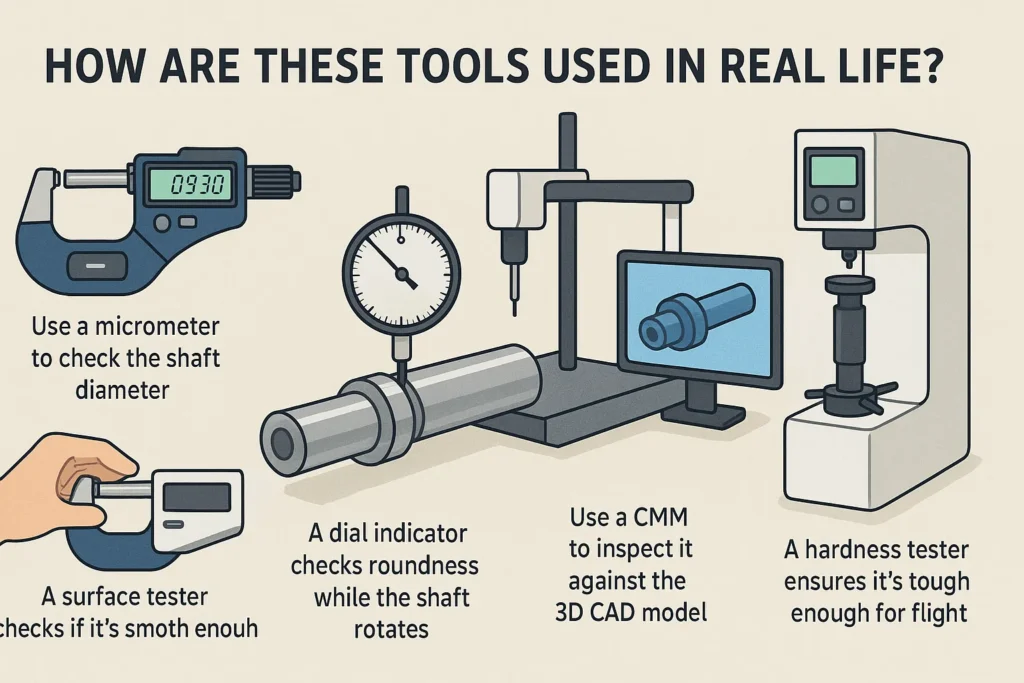
Choosing the Right Inspection Tool
To select the best tool for the job, consider:
- Part Size & Shape – Is it small like a bolt or large like a housing?
- Required Accuracy – Does it need 0.01 mm accuracy or is 1 mm enough?
- Material Type – Metal, plastic, rubber – each reacts differently.
- Production Volume – High-volume lines need faster, digital tools.
- Budget – Some tools like CMMs are expensive; others like calipers are affordable.
Tips to Improve Your Mechanical Parts Inspection Tools Process
- Calibrate tools regularly to avoid wrong readings.
- Train your staff to use tools properly.
- Use visual inspection with lighting to catch surface defects.
- Record every result for traceability.
- Update tools as tech improves (e.g., switch to digital).
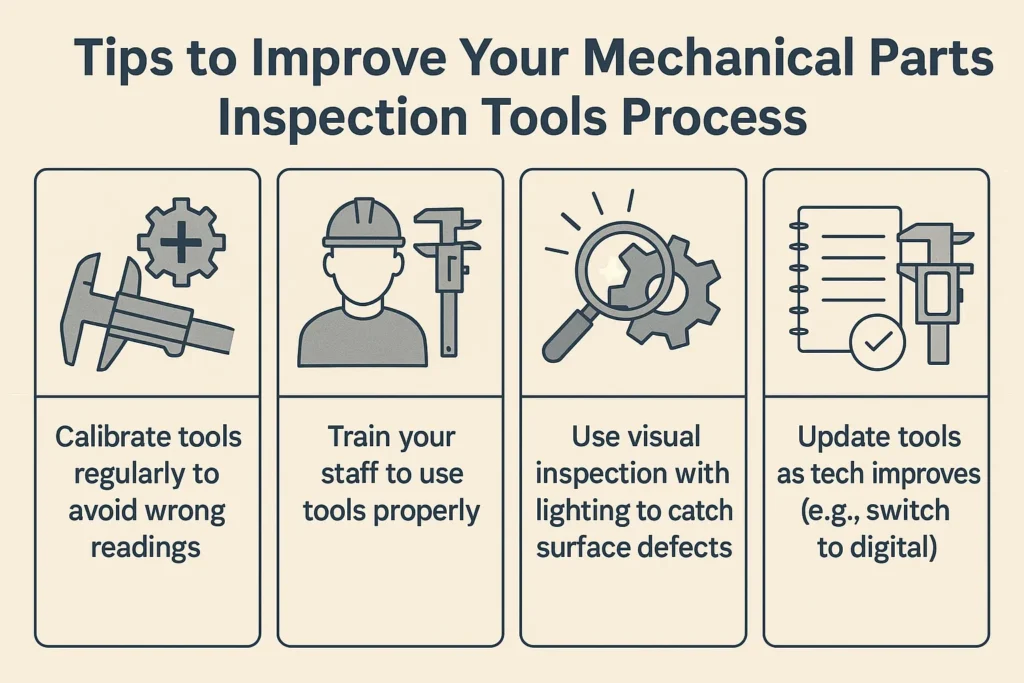
Benefits of Using Quality Inspection Tools
✅ Improves Product Quality
✅ Reduces Cost of Rework or Returns
✅ Boosts Customer Confidence
✅ Helps Pass Certifications (ISO, AS 9100)
✅ Enhances Workplace Safety
Real-Life Industries Using These Tools
- Aerospace: Jet engine part inspections
- Automotive: Brake system measurement
- Medical: Surgical tool accuracy
- Oil & Gas: Valve and joint checking
- Defense: Precision weapon system parts
Final Thoughts
Mechanical Parts Inspection Tools are the backbone of quality assurance in any manufacturing setup. Whether you’re making tiny screws or large machine parts, accurate inspection helps avoid failure, improve safety, and satisfy clients. As manufacturing moves toward automation and digitization, tools are becoming smarter and more precise than ever.
Investing in the right Mechanical Parts Inspection Tools is not just about compliance—it’s about building a reputation for excellence, reliability, and trust.
FAQ: Mechanical Parts Inspection Tools
Q1: What is the most common mechanical inspection tool?
The Vernier caliper is one of the most commonly used tools due to its accuracy, affordability, and ability to measure multiple dimensions.
Q2: How often should inspection tools be calibrated?
It’s best to calibrate tools every 6 to 12 months, depending on how often they’re used and the type of measurements they take.
Q3: Can I use digital tools instead of manual ones?
Yes! Digital tools like calipers, micrometers, and CMMs offer faster readings and higher precision, especially for complex or high-volume tasks.
Q4: Are these tools only for metal parts?
No. Inspection tools can be used for plastic, rubber, and composite parts too. The type of tool may change depending on the material.
Q5: Do I need expensive tools for inspection?
Not always. Simple tools like feeler gauges, rulers, and thread gauges are affordable and still useful for many everyday inspections.
Q6: What is the difference between CMM and optical comparator?
A CMM gives 3D measurements and is automated, while an optical comparator gives 2D visual comparisons of a part’s shape.

